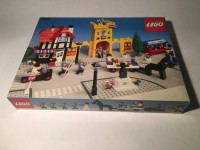
Many Lego-related blogs are written about modern sets. This especially applies to investment-related blogs. In a series of articles I try to generate enthusiasm for some of the more interesting vintage Lego sets. We enjoyed building them as kids, whereas probably more often we jealously admired them in our best friend's collection or in the Lego catalogue we devotedly picked up in the toy store. This is primarily a blog of nostalgia. However, investing in vintage Lego can be an interesting and fun pastime. The quest to find rarer sets, to restore incomplete sets and to assess your recently purchased lot of bricks can be exciting, relaxing and rewarding.
In this series of blogs I will describe sets, show pictures, provide general and set-specific information for collectors and investors, and finalize each blog with some fun stuff. After reading a couple of these blogs you'll hopefully get a certain confidence in this matter. Let's start with set 1592, the Town Square. Those who are not interested in this set's history and contents are invited to fast forward to the "tips for collectors and investors" below.
ABOUT SET 1592
There's a festival in town! It's the end of summer and everyone is out on the streets to celebrate the last days of sunshine. Behind the medieval castle walls there is a party. Here on the town square a procession comes by... a classic car, a flower float, minifigures in historical costumes... come and join the fun!
Of course, this set being a promotional item, there's a commercial detail. In this case, the minifigures are invited to have a soup with some smoked sausage.

HISTORY
This set was first issued in 1980 in the United Kingdom as a promotion for the British cereal producer Weetabix. Although the link between this set and cereals escapes me (the sign crowning the snack bar says "fish & chips" rather than "breakfast cereals") that doesn't make the set any less desirable. The UK set, produced between 1980 and 1982, features stickers "books", "ice cream", "Legoland carnival" and the UK flag.
After its initial sale in the UK, from 1981 the set was sold in Australia, Canada, Sweden, Germany1 as well as Japan2. Clicking this link will show you a German advert from around 1981. The advertiser, Fachgeschäft Spielzeugring (German toy retailer group), tells us this is a 'large city centre-themed gift set with a lot of content and endless playability'.
Then in 1983 a new set 1592 was issued, being a promotional item for the Dutch company Unilever. Already then one of the largest Netherlands-based companies, Unilever has produced a wide array of foods, cleaning articles and personal care products. One of the many brands held by Unilever is Unox, best known for its soup and its (delicious) typically Dutch smoked sausages. To this day movable carts just like the one seen in set 1592 are used to sell these sausages and sometimes soup. In winter soup with smoked sausage is just as commonly seen here as fish and chips are (or should I say, were) in the UK. So The Lego Group and Unilever both did the math, resulting into the advertisement seen here3 (scroll down a bit).
Translation left side:
"Send me Lego box no. 1592 "Village with procession" for the special Unox-price4 of €18,13 inclusive of shipment. I enclose payment plus 3 promo wrappers. N.b. of course you can order more than one Procession set. For every specimen, use a new order form plus 3 extra promo wrappers (maximum: 3 per family). U can also get the box without promo wrappers, in which case we will need to charge €2,97 shipment- and administrative costs. This promotion runs until December 1983."
Translation right side:
"Unique Lego box costing you only €18,13 plus 3 Unox promo wrappers (shop advice price €31,54). "Village with procession" true measurements 39x29cm. Enjoy that tasteful Unox soup while saving for that unique Lego procession box"
We are fortunate to know that the shop advice price was €31,54 even though this set was never available in any shop.
The Dutch version of the 1592 set was only produced for the year 1983 and it was only sold in the Netherlands. Even in 1983, some UK set production leftovers were delivered in the Netherlands. This is what Gary Istok says5:
"A Dutch acquaintance was a LEGO fan as a child... along with his 2 brothers... And their parents sent in 3 sets of UNOX Soup labels and money to get 3 of the Dutch 1592 sets. Well guess what arrived?? 2 Dutch and 1 British version of the 1592 sets!!"
All of this makes Dutch 1592 the rarer of the two variants and also the most sought-after.
SET SPECIFICS AND CONTENTS
The set comprises of 471 or 4916 parts, 10 minifigures 1 statue and 1 steroids-fed horse. Let's first look at the minifigures, horse and vehicles.
Back row, left to right: a statue, costumed man (with cup for soup!), book seller, convertible car driver, 4 knights, soup and sausage seller (previous job: fish & chips seller), flower float driver, flower queen.
Front row: convertible classic car, horse, flower float.
There are stickers for the knight shields, knight torsos and horse eyes. I'm not sure the eyes are all that realistic and if aligned carefully they will make your horse resemble cookie monster quite realistically. One year later, in 1984, The Lego Group would issue a horse part (Bricklink: #4493c01pb02) with slightly less disturbing eyes. The convertible car is a very neat little build, cleverly using a pile of 2x2 wheel plate + 2x8 plate + wheel fender + 2x3 plate + 2x2 plate to make a black grille.
On with the castle walls. Even the first time I built this set, probably as a six-year-old, I thought this was supposed to depict a relic rather than an 'abstract' full castle. This was one of the reasons I liked the set so much: it stimulated the fantasy (history of the castle, what's behind those walls now?)
A child could choose to pose the knights on and around the castle, or to let them walk in the parade. Probably, behind the castle walls other festival activities were going on. According to the poster, the festival took place from the 28th of August until the 4th of September. The Dutch flag consists of a white part + two stickers. The flag in the UK set had UK stickers, as mentioned.
The second building is the book shop. The UK set has a sticker "books" for the kiosk one. The building is just lovely! The half-timbered structure is represented convincingly and the use of then-new windows and -door are very charming. The roof structure is rather complex and is fun to build. The building's only flaw is the use of the striped stickers on the canopy. I'll come back to that later. On the above picture you can also see the cypress tree which is considered a rather rare piece. Not as rare as finding one actual cypress tree within the boundaries of a Dutch city though.
As can be seen in the above picture, the book shop even has a modest interior.
The rest of the set consists of two lampposts, a statue of a guy, a STOP traffic sign, a blue bench, fruit tree, an avalanche of flowers (some in pots) and of course the soup with smoked sausage stand. The sticker sheet contains alternate stickers "vers schepijs" ('fresh ice cream').
A main picture of the box can be seen in the beginning of this blog. Here are pictures of the sides of the box (third image is shown on both shorter outsides of the inner box):
The bottom side of the box:
Lastly, the inner box, sticker sheet and instructions.
Note that there are spares for most stickers: 5 knight torsos, 3 knight shields, 3 kiosks, 2 statue stickers, 3 snack bar stickers, 3 pairs of terrified horse eyes and 1 festival poster. Most unfortunately, the two weakest and rarest stickers (shop canopy) are not offered as spares.
On the picture you can also see the great build of the car. Check out the way the designer designed that grille!
TIPS FOR COLLECTORS AND INVESTORS
Those who are interested in purchasing / investing in this set should note the following:
- While the UK set (1592-1) and the Dutch set (1592-2) are both quite rare, 1592-2 is the less common of the two.
- The 2008 Lego Collector Guide rates the rarity of 1592-1 as 5/6 stars and 1592-2 as 6/6 stars.
- According to the amazing Unofficial Lego Sets / Parts Collectors Guide7 the value of an excellent condition set (minor wear, box and contents are in well cared for condition) is 200 to 250 euros.
- In case you're planning to gather this set from several sources, try to start with a boxed version with incomplete stickers. Check the state of both inner- and outer box. If ordering online, ask for several pictures.
- After you've found a box(ed incomplete set), make the canopy stickers your next project. These are almost always gone, because they span multiple sloped tiles without much grip and there are no spares on the sticker sheet. To make matters worse, these stickers have a slight overhang. I reckon most canopy stickers were thrown away after building and disassembling the set once.
- Having found a box and all stickered parts makes life easy. None of the parts are exclusive to this set. Nonetheless, some are difficult to find such as the four black lantern cap parts, only present in two other rare sets; the above-mentioned cypress tree, currently for sale on Bricklink for at least €11,50; the unstickered knight shield, only to be found in two other sets; the two red doors and the black statue head which was only used in 4 other sets. You'll probably have to Bricklink these parts if not present. A full inventory of Lego set 1592 can be found here.
- Make sure the white flag part, the STOP sign and the two base plates are intact and unglued, the large black statue head hasn't been replaced by the more common cilinder part, the stickered knight torsos have not been replaced by similar looking torsos and the knight legs have not been replaced by other color combo legs.
- Check that the bricks (especially white, blue and grey) have not been discolored. If you want to try to restore the original color, read this blog carefully.
- Ideally the stickers have not applied at all; if so, they should have been applied as neatly as possible. Make sure the festival stickers have not been torn (like the canopy stickers, they span multiple bricks).
- If a sticker sheet is present, check for authenticity. The backside of an original sticker sheet reads "FasCal REMOVABLE", the sheet number is 195145. Beware that sticker sheets are being reproduced nowadays.
- Usually the best place to find rare Lego sets are Brick Classifieds (good deals), Bricklink (varied offer) or Ebay (quick purchases). As 1592-2 was only sold in the Netherlands, it's not easy to find it elsewhere. So you'll have to think out of the box. Introducing... the Dutch virtual market place Marktplaats. There you'll probably find one or more 1592s offered for sale. You'll find Marktplaats to be a bit different from the three above-mentioned platforms. First, bidding is possible but it doesn't bind you. So it really has no validity whatsoever. It's always a good idea to directly contact the seller, telling you that you're a foreign collector (or investor, if you think that's wise) of Lego and that you're interested in their set. Ask the seller if he will ship to where you're living. Then the awkward part: if you don't have a Dutch friend who can pick it up for you, you'll have to trust the seller and pay him or her trusting that they'll send you what you bought. It's a bit tricky but I never had a bad experience in the 10+ years I bought and sold through Marktplaats. Wise thing to do before paying any money: check how many years the seller has been a Marktplaats member, then Google the seller's name co-using the words "fraude" or "vals". Have Google translate the search results and conclude. I always ask for the seller's address, explaining it is for my own protection. Literally everybody gave their address without any objection. In the end you can never be 100% sure but it's better than nothing.
-
Once you've completed the set, clean the parts (good method: by hand, see this thread) and ideally put them away in a dark, air-conditioned closet so the discoloring process of both bricks and box will be minimal. Or display it... after all it's a grand piece!
FUN STUFF
On with the fun stuff. First, a picture of two sets of Dutch instructions.
- Can you see what's wrong with the bottom one? Here's the answer. Unilever, holding company of cleaning solution brands, was clearly thought to sell sausages as well was soap during the Legoland festival. This funny error is continued on the two last pages of the instructions. I'm not sure when exactly the instructions were corrected. I have not heard of incorrect stickers or boxes. If anyone has those or knows they exist, please let me know.
- While the instructions of 1592-2 correctly mention copyright 1983, the box incorrectly says 1980 (clearly copying the 1592-1 box).
- This set is considered by some as one of the best The Lego Group has ever produced (see these and these reviews. It still inspires people... check out this awesome remake!
- Who's the statued guy? Living 1807-1872 it could be Italian cellist, educator and composer Carlo Curti, or British lawyer, diplomat and writer Henry Charles Sirr. Frankly and unfortunately I haven't been able to find any plausible candidate for this statue to imply an easter egg. If anyone finds out anything interesting on the matter of the statue, do let me know!
- 2 years before the UK release of the Town Square, another interesting set was released. In 1589 (Main Street) we can spot... a piece of yellow castle wall, just as tall and with the same battlements as seen in 1592. It gives reason to believe both walls belong to the same castle. Nice detail for those kids who really paid attention. The castle bits of these sets also remind of castle set 375.
- Last, not least! I know all of you have been desperately waiting for the answer to the question "so what's the difference between 1592-1's and 1592-2's boxes?" Well, TLG definitely did its best to make both boxes look as similar as possible, probably in an attempt to get away with delivering some stock 1592-1 boxes to Dutch customers... comparing both boxes very closely, the differences are barely noticeable (except for the stickers, of course). The car and flower float have moved a bit, the knights' heads are positioned slightly differently, the shadowing, the background color... all a bit different. But the trees, lampposts, minifigure gestures and door positions are just the same. Perhaps as an insider joke, there's one difference though... the flowers! Some of the several flowers differ in color. And behold... one bed of flowers was even added to the 1592-2 box picture! In all you really have to look carefully... (top: 1592-1, bottom: 1592-2 box fragments).
References
1 See this Bricksetforum post written by Lego historian Gary Istok.
2 See this post on the Eurobricks forum written by Lego historian Gary Istok.
3 See this post on the Eurobricks forum.
4 The price in Dutch guilders was fl.39,95.
5 See this post on the Eurobricks forum.
6 The 2008 Lego Collector Guide p166.
7 Unofficial Lego Sets / Parts Collectors Guide, Gary Istok, price list. To see prices for very good, MIB- and MISB-conditions I strongly advise anyone to buy Mr Istok's magnum opus. It simply is a treasure chest loaded with facts, figures and pictures of every imaginable Lego-subject from the 30s up to and until the 90s. See here for a bunch of teasers and here to purchase it. Set 1592-1 is discussed in chapter 17 page 18, set 1592-2 in chapter 17 page 28.
Edited by Roy vd M.
-
 4
4


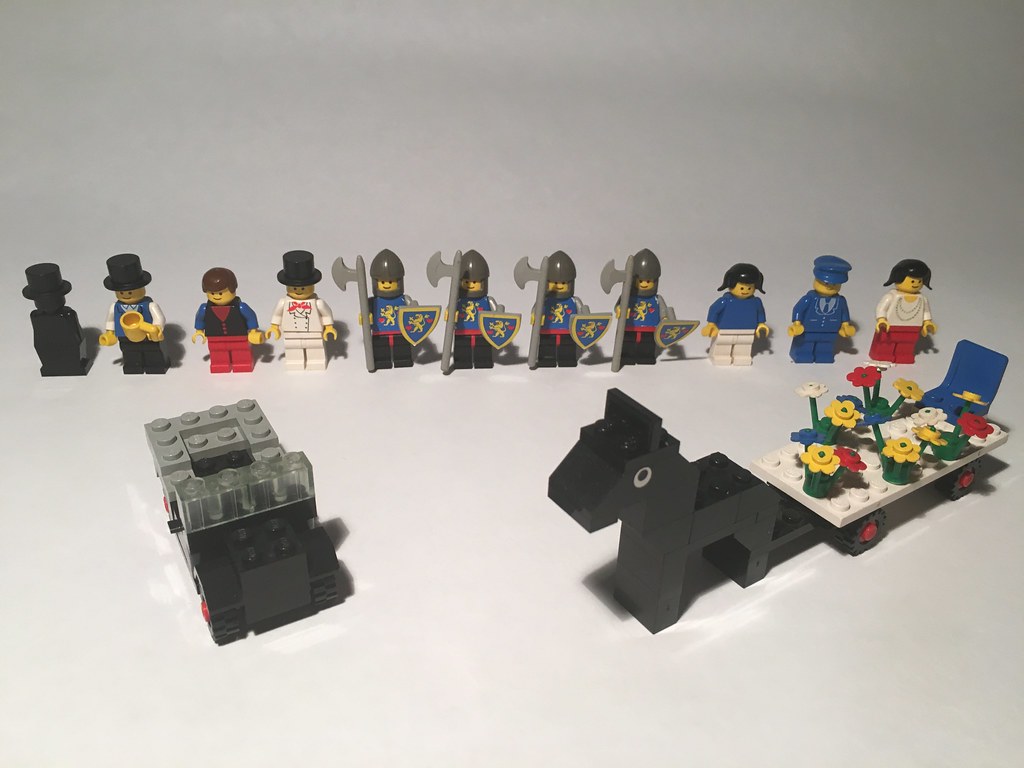
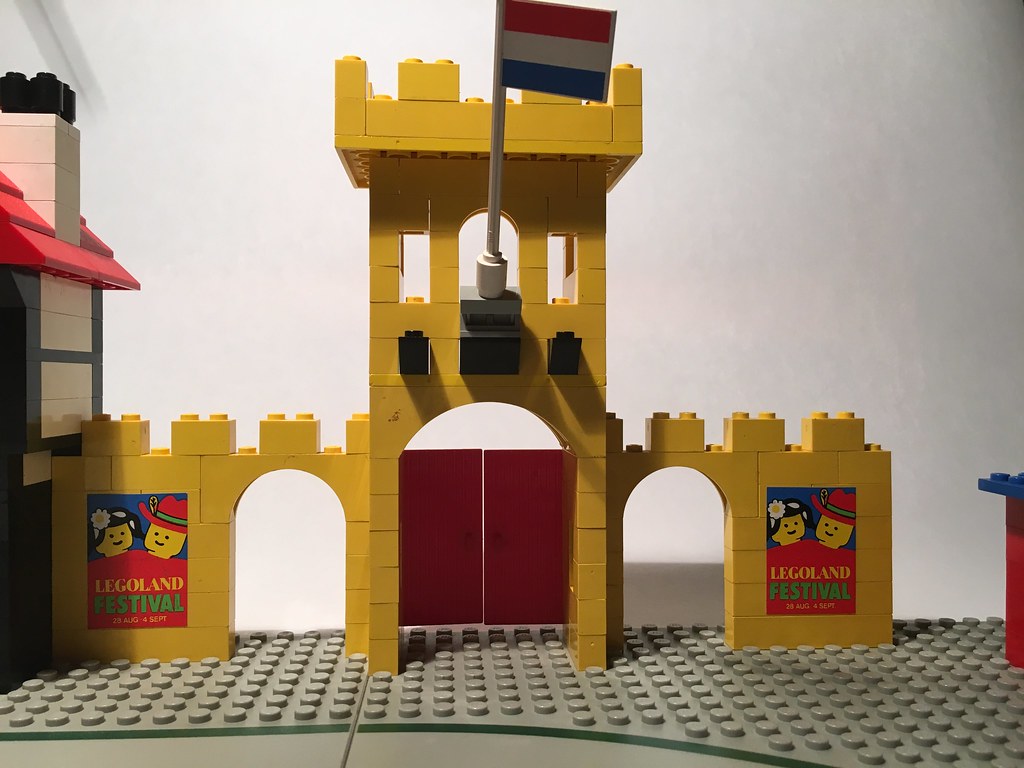





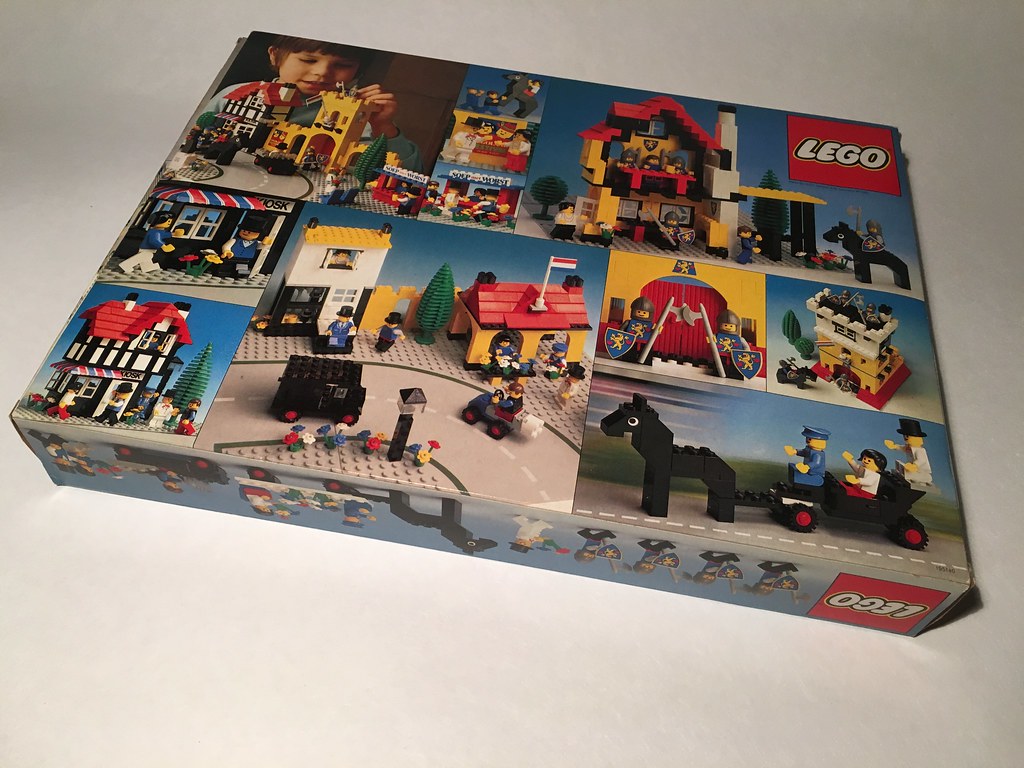
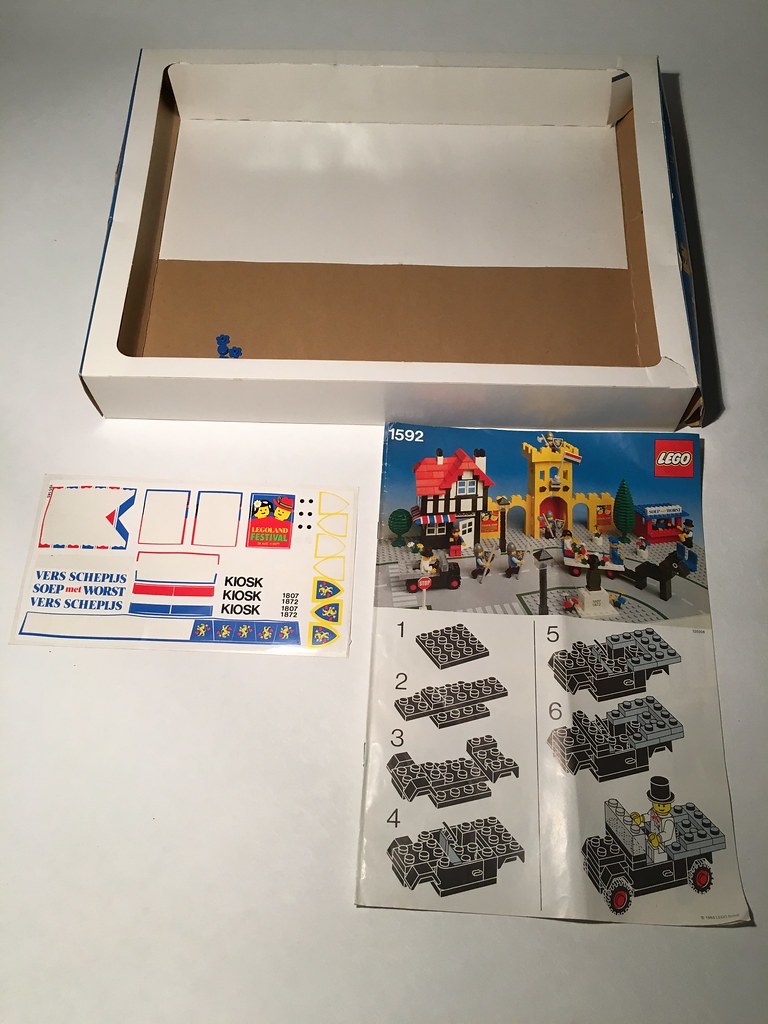
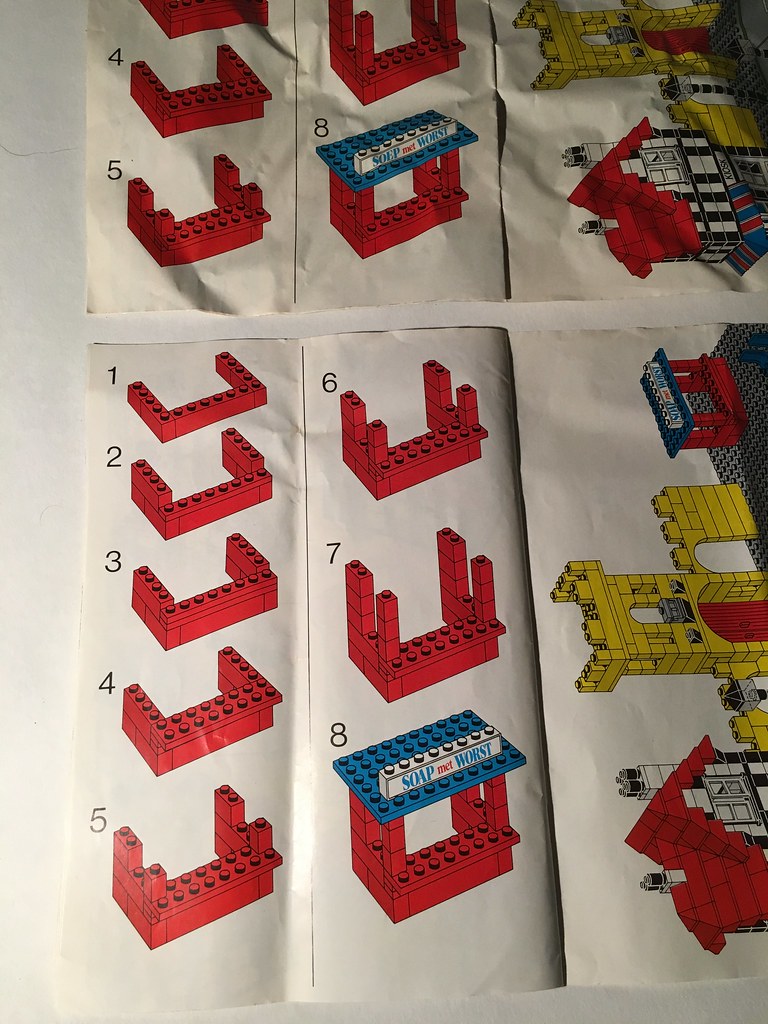
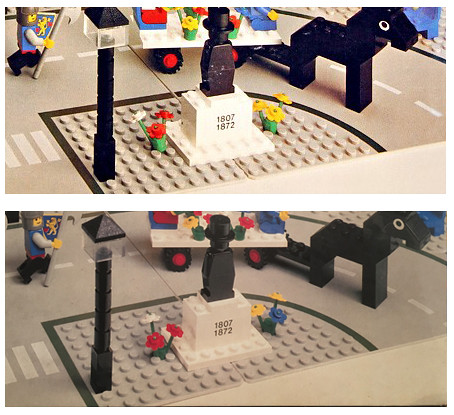



Recommended Comments
Join the conversation
You can post now and register later. If you have an account, sign in now to post with your account.
Note: Your post will require moderator approval before it will be visible.